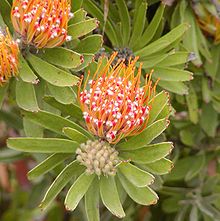
Back Leucospermum Afrikaans Leucospermum Catalan Leucospermum CEB Leucospermum German Leucospermum Spanish گل جاسوزنی Persian Neulaproteat Finnish Leucospermum French Leucospermum Dutch Leucospermum Polish
| Leucospermum | |
|---|---|

| |
| Leucospermum erubescens | |
| Scientific classification | |
| Kingdom: | Plantae |
| Clade: | Tracheophytes |
| Clade: | Angiosperms |
| Clade: | Eudicots |
| Order: | Proteales |
| Family: | Proteaceae |
| Subfamily: | Proteoideae |
| Tribe: | Leucadendreae |
| Subtribe: | Leucadendrinae |
| Genus: | Leucospermum R.Br. |
| Type species | |
| Leucospermum hypophyllocarpodendron[1] | |

| |
| native range | |
| Synonyms[2] | |
Leucospermum is a genus of evergreen upright, sometimes creeping shrubs that is assigned to the Proteaceae, with currently forty-eight known species.
The shrubs mostly have a single stem at their base, but some species sprout from an underground rootstock, from which the plant can regrow after fire has killed the above ground biomass. In a larger group of species, specimens are killed by fire, and their survival depends on the seeds. In all species, seeds are collected by ants, which take them to their underground nests to feed on their ant breads, a seed dispersal strategy known as myrmecochory. This ensures that the seeds do not burn, so new plants can grow from them.
Leucospermum species mostly have seated, simple, mostly leathery, often softly hairy leaves, set in a spiral, with entire margins or more often, with 3–17 blunt teeth with thickened, bony tips, and without stipules at their foot. The flowers are organised with many together in heads with bracts on the under- or outside. The hermaphrodite flowers themselves are set on a common base that may be cylindrical, conical or flat, and have small bracts at their base. The flowers have a perianth that is hairy on the outside, particularly at the tip, and consists of four tepals that are merged into a tube. Usually the four anthers are merged individually with the tip the perianth lobes, and only in a few species, a very short filament is present that further down cannot be distinguished from the tepals anymore. While still in the bud, the pollen is transferred from the anthers to the pollen-presenter, a thickening at the tip of the style. At that stage, the style grows considerably and rips through the sutures between the two perianth lobes facing away from the centre of the flower head. The perianth lobes all four remain attached to each other, or with three, or the four free lobes all curl back on themselves (like the lid of a sardine can), rimming the top of the tube. The superior ovary consists of one carpel and contains a single ovary, and is subtended by four small scales. The fruit is an oval or almost globe-shaped nut.
Most species have very limited ecological ranges and distribution areas, and many are rare or endangered. The often attractive, large flower heads and evergreen foliage, the straight stems, combined with long flowering period makes that Leucospermum species and their hybrids are bred as garden ornamental and cut flower.
- ^ "Leucospermum R.Br". Tropicos.
- ^ Rourke, John Patrick (1970). Taxonomic Studies on Leucospermum R.Br (PDF).